
Pirate Flags

For almost three centuries a black flag with a white skull and crossbones (Jolly Roger) has been the symbol for pirates throught-out the western world. The flag was meant to strike fear into victims and encourage a hasty surrender. In popular fiction all pirates flew the Jolly Roger. However, this special flag was first used mainly by British and British-American pirates beginning around 1700. Other pirates attacked either under their own ruler's flag or under the flag of the official issuing their privateering commission. By flying a national flag, pirates made a symbolic statement (often false) that the attack was legal under that country's laws. Some nations sponsored piracy and lived off pirate booty, including Barbary states, the Knights of Malta, and 17th-century England. In law, corsairs operating from one of these havens had to fly its flag. This showed that the raiders recognized and paid taxes to the ruler's law courts.

The pirate flag probably traces its origins to the plain black flag that a ship would fly to warn another to surrender at once, or else it would be replaced by the red flag, or 'Jolie Rouge' in French, meaning no quarter given (no mercy would be given to the crew). This French name may be where the term 'Jolly Roger' originated. Another possiblity comes from the word 'Roger'. In late 17th century England the word 'rouge' was used in association with the rogue laws, limiting vagrancy in England. 'Roger' sprang from this, and was used as a slang word for a vagabond, beggar or vagrant. Also another possibility comes from the fact that the devil was sometimes referred to as 'Old Roger', so the flag suggested the wrath of the devil. Many of these flags were made by the pirate ship's sailmaker or any member of the crew who was handy with a needle and thread.

Most pirate flags show skulls and crossbones or skeletons, meant to warn of death if the victim did not surrender. Many of these symbols were probably borrowed from gravestones of the time. A few of the flags also contain an hour glass, meaning that time is running out for the victim to surrender peacefully. The pirates wanted to project fearlessness in the face of death, and some flags pictured the captain toasting, dancing with, or literally conquering the skeletal dead. Hearts to were often pierced to symbolize "no mercy". In an era where symbolism in art and everyday life was commonplace, each symbol had a distinct and immediately recognisable meaning. Also pirate flags were a very important form of psychological warfare, especially when combined with a reputation of not showing any mercy if opposed. If pirates could intimidate an enemy to heave-to and surrender without offering any resistance, then the harm they faced would be greatly eliminated.

Images of Famous Pirate Flags
|
CLICK ON PICTURES BELOW FOR LARGER VIEW
|
|||
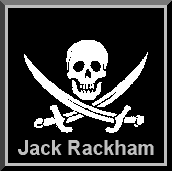
|

|

|

|

|

|
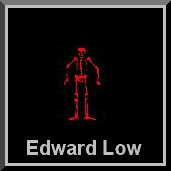
|
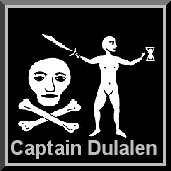
|

|
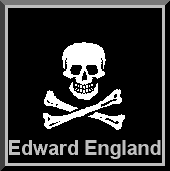
|
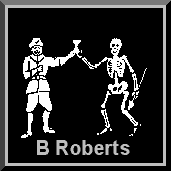
|
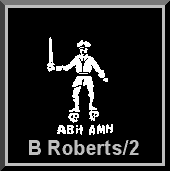
|
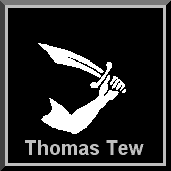
|

|

|

|

Flags Used by Famous Pirates

One of the first known pirates to use the basic skull and crossed bones was Henry Every in 1696. His flag showed a skull turned to the side. Originally his flag had a red background and later this was changed to black. Around 1700 French privateer Emmanuelle Wynne flew a black flag embellished with a skull, crossbones and an hourglass. Shortly afterwards, additional symbols on the basic red or black flag were increasingly associated with piracy, and these custom flags were in turn associated with individual pirate captains. The most common symbol was the skull, the symbol of death. It was also frequently depicted in association with crossed bones, another death symbol. Pirate Edward England flew the skull and crossed bones in it's pure form. While Christopher Condent's banner repeated the same skull and crossed bones emblem three times.

Later pirates often combined symbols. Such as Christopher Moody who used a skull and crossed bones, a raised sword and a winged hourglass on his flag. Bartholomew Roberts flag showed a pirate holding an hourglass, alongside a skeleton clutching a spear. He also bore a grudge against the island colonies of Barbados and Martinique, so in their waters he used a flag showing a pirate figure (presumably Roberts himself) standing on two skulls. Under one were the letters 'ABH' (standing for 'A Barbadian's Head'), and under the other was 'AMH' (for 'A Martiniquan's Head'). His threat was clear that sailors from those colonies could expect no mercy. Edward Teach (better known as Blackbeard) flew a flag depicting a horned skeleton holding an hourglass and a spear next to a bleeding heart. In 1718 Charles Vane flew the English flag from one mast and a black pirate flag from another.

While they were hunting, many pirates either flew no flag or used one that was meant to fool their intended victim. Normally their battle flag was raised only when they were close enough to attack. On one occasion the famous pirate Bartholomew Roberts was able to deceive the shipping off the island of Martinique by flying Dutch flags and making signals normally used by Dutch ships arriving from the Guinea coast of Africa with black slaves. This ruse enabled him to capture fourteen French sloops which came out to meet him with large sums of money on board for trading in slaves. Naval warships also used these tricks. In 1815 American ships thus trapped the 'Hamidou Reis' by flying the British flag. Some pirates, such as Blackbeard kept a collection of flags on board and simply raised whatever was most convenient in any given situation.

Page best viewed with a 1024x768 screen resolution.
Copyright © 2000-2008 Brethren of the Coast, All Rights Reserved.